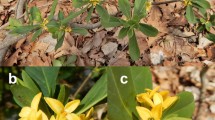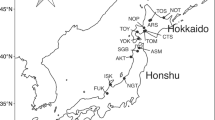Abstract
In gynodioecious plant species, females can only persist when they have a reproductive advantage in comparison with hermaphrodites. However, several studies have shown that females do not necessarily produce more seeds than hermaphrodites, since seed production can be affected by population characteristics, such as female frequency or population size. The aim of this study was to quantify the female advantage across a large number of natural populations, examine its relationship with population sex ratio and size, and to assess the role of competition on the magnitude of the female advantage. We sampled 27 populations of Plantago coronopus (nuclear–cytoplasmic gynodioecy) along the Belgian and Dutch coast. In each population, we estimated population sex ratio and size, and assessed seed production per flower and seed production per plant. Subsequently, germination, growth, and competition experiments were performed in the greenhouse to determine the female advantage regarding offspring quality. Females produced fewer seeds per plant than hermaphrodites (FA = 0.90), and seed production was negatively related to female frequency. Since both sex morphs were equally affected by pollen availability, the female advantage was not related to population sex ratio. On the other hand, offspring of females showed higher germination and growth rates, resulting in higher competitive abilities when seeds of a female and a hermaphrodite were grown together. Overall, these results indicate that differences in competitive abilities between the offspring of females and hermaphrodites may have contributed to the maintenance of females in relatively high frequencies in populations of this short-lived gynodioecious plant species.




Similar content being viewed by others
References
Alonso C, Herrera CM (2001) Neither vegetative nor reproductive advantages account for high frequency of male-steriles in southern Spanish gynodioecious Daphne laureola (Thymelaeaceae). Am J Bot 88:1016–1024
Bates DM, Mächler M, Bolker BM, Walker SC (2014) Fitting linear mixed-effects models using lme4. http://cran.r-project.org/web/packages/lme4/vignettes/lmer.pdf
Byers DL, Warsaw A, Meagher TR (2005) Consequences of prairie fragmentation on the progeny sex ratio of a gynodioecious species, Lobelia spicata (Campanulaceae). Heredity 95:69–75. doi:10.1038/sj.hdy.6800692
De Cauwer I, Arnaud J-F, Schmitt E, Dufay M (2010a) Pollen limitation of female reproductive success at fine spatial scale in a gynodioecious and wind-pollinated species, Beta vulgaris ssp. maritima. J Evol Biol 23:2636–2647. doi:10.1111/j.1420-9101.2010.02119.x
De Cauwer I, Dufay M, Cuguen J, Arnaud J-F (2010b) Effects of fine-scale genetic structure on male mating success in gynodioecious Beta vulgaris ssp. maritima. Mol Ecol 19:1540–1558. doi:10.1111/j.1365-294X.2010.04586.x
De Cauwer I, Dufay M, Hornoy B et al (2012) Gynodioecy in structured populations: understanding fine-scale sex ratio variation in Beta vulgaris ssp. maritima. Mol Ecol 21:834–850. doi:10.1111/j.1365-294X.2011.05414.x
Collin CL, Shykoff JA (2003) Outcrossing rates in the gynomonoecious-gynodioecious species Dianthus sylvestris (Caryophyllaceae). Am J Bot 90:579–585
Connor HE (1990) Breeding systems in New Zealand grasses IX. Gynodioecism in Chionochloa bromoides. New Zeal J Bot 28:59–65. doi:10.1080/0028825X.1963.10428998
Dornier A, Dufay M (2013) How selfing, inbreeding depression, and pollen limitation impact nuclear-cytoplasmic gynodioecy: a model. Evolution 67:2674–2687. doi:10.1111/evo.12142
Dufay M, Billard E (2012) How much better are females? The occurrence of female advantage, its proximal causes and its variation within and among gynodioecious species. Ann Bot 109:505–519. doi:10.1093/aob/mcr062
Dufay M, Lahiani E, Brachi B (2010) Gender variation and inbreeding depression in gynodioecious-gynomonoecious Silene nutans (Caryophyllaceae). Int J Plant Sci 171:53–62. doi:10.1086/647916
Eckhart VM, Chapin FS (1997) Nutrient sensitivity of the cost of male function in gynodieocious Phacelia linearis (Hydrophyllaceae). Am J Bot 84:1092–1098
García-Franco JG, Arroyo MTK (1995) Breeding system, sex ratio and individual size of the gynodioecious Nototriche compacta (Malvaceae) in the Andes of Central Chile. Plant Species Biol 10:147–153. doi:10.1111/j.1442-1984.1995.tb00134.x
Gibson JP, Wheelwright NT (1996) Mating system dynamics of Ocotea tenera (Lauraceae), a gynodioecious tropical tree. Am J Bot 83:890–894. doi:10.2307/2446266
Gouyon PH, Vichot F, van Damme JMM (1991) Nuclear-cytoplasmic male sterility: single-point equilibria versus limit cycles. Am Nat 137:498–514. doi:10.1086/285179
Graff A (1999) Population sex structure and reproductive fitness in gynodioecious Sidalcea malviflora malviflora (Malvaceae). Evolution 53:1714–1722. doi:10.1111/j.1558-5646.1999.tb04556.x
Hultén E, Fries M (1986) Atlas of north European vascular plants. North of the Tropic of Cancer. Maps 1-996. Koeltz Scientific Books, Oberreifenberg
Husband B, Schemske D (1996) Evolution of the magnitude and timing of inbreeding depression in plants. Evolution 50:54–70. doi:10.1111/j.1558-5646.1996.tb04472.x
Kawakubo N (1994) Gynodioecy in Cirsium chikushiense Koidz. (Compositae). Ann Bot 74:357–364. doi:10.1006/anbo.1994.1128
Koelewijn HP (2004) Rapid change in relative growth rate between the vegetative and reproductive stage of the life cycle in Plantago coronopus. New Phytol 163:67–76. doi:10.1111/j.1469-8137.2004.01078.x
Koelewijn HP, van Damme JMM (1995) Genetics of male sterility in gynodioecious Plantago coronopus. I. Cytoplasmic variation. Genetics 139:1749–1758
Koelewijn HP, van Damme JMM (1996) Gender variation, partial male sterility and labile sex expression in gynodioecious Plantago coronopus. New Phytol 132:67–76. doi:10.1111/j.1469-8137.1996.tb04510.x
Lahiani E, Touzet P, Billard E, Dufay M (2015) When is it worth being a self-compatible hermaphrodite? Context-dependent effects of self-pollination on female advantage in gynodioecious Silene nutans. Ecol Evol 5:1854–1862. doi:10.1002/ece3.1410
Lewis D (1941) Male sterility in natural populations of hermaphroditic plants. The equilibrium between females and hermaphrodites to be expected with different types of inheritance. New Phytol 40:56–63. doi:10.1111/j.1469-8137.1941.tb07028.x
Lloyd DG (1975) The maintenance of gynodioecy and androdioecy in angiosperms. Genetica 45:325–339
Mazer SJ, Moghaddasi A, Bello AK, Hove AA (2016) Winning in style: longer styles receive more pollen, but style length does not affect pollen attrition in wild Clarkia populations. Am J Bot 103:408–422. doi:10.3732/ajb.1500192
McCauley DE (1998) The genetic structure of a gynodioecious plant: nuclear and cytoplasmic genes. Evolution 52:255–260. doi:10.1111/j.1558-5646.1998.tb05159.x
McCauley DE, Brock MT (1998) Frequency-dependent fitness in Silene vulgaris, a gynodioecious plant. Evolution 52:30–36. doi:10.2307/2410917
McCauley DE, Taylor DR (1997) Local population structure and sex ratio: evolution in gynodioecious plants. Am Nat 150:406–419. doi:10.1086/286072
Miyake K, Miyake T, Terachi T, Yahara T (2009) Relative fitness of females and hermaphrodites in a natural gynodioecious population of wild radish, Raphanus sativus L. (Brassicaceae): comparison based on molecular genotyping. J Evol Biol 22:2012–2019. doi:10.1111/j.1420-9101.2009.01808.x
Morris WF, Doak DF (1998) Life history of the long-lived gynodioecious cushion plant Silene acaulis (Caryophyllaceae), inferred from size-based population projection matrices. Am J Bot 85:784–793
Mulcahy DL (1971) A correlation between gametophytic and sporophytic characteristics in Zea mays L. Science 171:1155–1156. doi:10.1126/science.171.3976.1155 (80-)
Nilsson E, Ågren J (2006) Population size, female fecundity, and sex ratio variation in gynodioecious Plantago maritima. J Evol Biol 19:825–833. doi:10.1111/j.1420-9101.2005.01045.x
Olff H, Kuiper D, Vandamme JMM, Kuiper PJC (1989) Gynodioecy in Plantago lanceolata. VI. Functions of cytokinins in growth development, and reproduction of two sex types. Can J Bot 67:2765–2769. doi:10.1139/b89-356
Olson MS, Graf AV, Niles KR (2006) Fine scale spatial structuring of sex and mitochondria in Silene vulgaris. J Evol Biol 19:1190–1201. doi:10.1111/j.1420-9101.2006.01103.x
Puterbaugh MN, Wied A, Galen C (1997) The functional ecology of gynodioecy in Eritrichum aretioides (Boraginaceae), the alpine forget-me-not. Am J Bot 84:393–400. doi:10.2307/2446012
R development core team (2015) R: a language and environment for statistical computing. http://www.r-project.org/
Ramsey M, Vaughton G (2002) Maintenance of gynodioecy in Wurmbea biglandulosa (Colchicaceae): gender differences in seed production and progeny success. Plant Syst Evol 232:189–200. doi:10.1007/s006060200042
Shykoff JA (1992) Sex polymorphism in Silene acaulis (Caryophylaceae) and the possible role of sexual selection in maintaining females. Am J Bot 79:138–143
Shykoff JA, Kolokotronis S-O, Collin CL, López-Villavicencia M (2003) Effects of male sterility on reproductive traits in gynodioecious plants: a meta-analysis. Oecologia 135:1–9. doi:10.1007/s00442-002-1133-z
Stevens DP (1988) On the gynodioecious polymorphism in Saxifraga granulata L. (Saxifragaceae). Biol J Linn Soc 35:15–28. doi:10.1111/j.1095-8312.1988.tb00455.x
Talavera S, Arista M, Salgueiro FJ (1996) Population size, pollination and breeding system of Silene stockenii Chater (Caryophyllaceae), an annual gynodioecious species of southern Spain. Bot Acta 109:333–339. doi:10.1111/j.1438-8677.1996.tb00581.x
van Damme JMM (1991) A restorer gene in gynodioecious Plantago coronopus subject to selection in the gametophytic and seedling stage. Heredity 66:19–27. doi:10.1038/hdy.1991.3
Van Etten ML, Deen AC, Hamrick JL, Chang S-M (2014) Mating system contributes only slightly to female maintenance in gynodioecious Geranium maculatum (Geraniaceae). Heredity 113:464–470. doi:10.1038/hdy.2014.48
Villellas J, Ehrlén J, Olesen JM et al (2013) Plant performance in central and northern peripheral populations of the widespread Plantago coronopus. Ecography 36:136–145. doi:10.1111/j.1600-0587.2012.07425.x
Weller SG, Sakai AK (2005) Selfing and resource allocation in Schiedea salicaria (Caryophyllaceae), a gynodioecious species. J Evol Biol 18:301–308. doi:10.1111/j.1420-9101.2004.00835.x
Zhang YW, Wang Y, Yu Q, Zhao JM (2008) Sex expression, female frequency, and reproductive output in a gynodioecious clonal herb, Glechoma longituba (Lamiaceae). Plant Ecol 199:255–264. doi:10.1007/s11258-008-9430-1
Acknowledgements
This work was supported by the Research Foundation-Flanders (FWO) [Grant No 11G1715N to S.M.] and the European Research Council [ERC starting Grant 260601-MYCASOR to H.J.]. We thank Jelle S. van Zweden for his help during fieldwork and Kasper Van Acker and Timmy Reijnders for their help in the greenhouse. We would also like to thank three anonymous reviewers and the handling editor for their helpful comments and suggestions.
Author information
Authors and Affiliations
Contributions
SM and HJ formulated the idea; SM performed the fieldwork; SM, TS, and SV performed the growth experiments; SM, TS, and SV analysed the data; and SM and HJ wrote the manuscript.
Corresponding author
Additional information
Communicated by Jennifer A. Lau.
Electronic supplementary material
Below is the link to the electronic supplementary material.
Rights and permissions
About this article
Cite this article
van der Meer, S., Sebrechts, T., Vanderstraeten, S. et al. The female advantage in natural populations of gynodioecious Plantago coronopus: seed quantity vs. offspring quality. Oecologia 185, 653–662 (2017). https://doi.org/10.1007/s00442-017-3981-6
Received:
Accepted:
Published:
Issue Date:
DOI: https://doi.org/10.1007/s00442-017-3981-6




